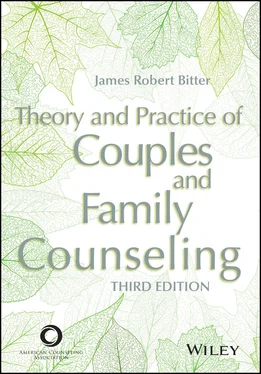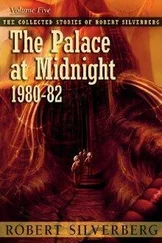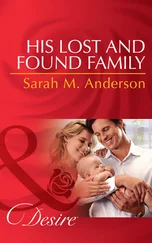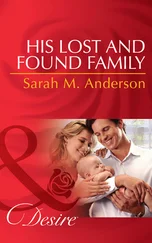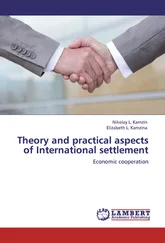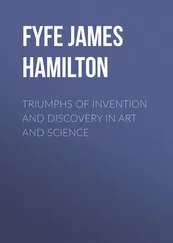James Robert Bitter - Theory and Practice of Couples and Family Counseling
Здесь есть возможность читать онлайн «James Robert Bitter - Theory and Practice of Couples and Family Counseling» — ознакомительный отрывок электронной книги совершенно бесплатно, а после прочтения отрывка купить полную версию. В некоторых случаях можно слушать аудио, скачать через торрент в формате fb2 и присутствует краткое содержание. Жанр: unrecognised, на английском языке. Описание произведения, (предисловие) а так же отзывы посетителей доступны на портале библиотеки ЛибКат.
- Название:Theory and Practice of Couples and Family Counseling
- Автор:
- Жанр:
- Год:неизвестен
- ISBN:нет данных
- Рейтинг книги:5 / 5. Голосов: 1
-
Избранное:Добавить в избранное
- Отзывы:
-
Ваша оценка:
- 100
- 1
- 2
- 3
- 4
- 5
Theory and Practice of Couples and Family Counseling: краткое содержание, описание и аннотация
Предлагаем к чтению аннотацию, описание, краткое содержание или предисловие (зависит от того, что написал сам автор книги «Theory and Practice of Couples and Family Counseling»). Если вы не нашли необходимую информацию о книге — напишите в комментариях, мы постараемся отыскать её.
Theory and Practice of Couples and Family Counseling — читать онлайн ознакомительный отрывок
Ниже представлен текст книги, разбитый по страницам. Система сохранения места последней прочитанной страницы, позволяет с удобством читать онлайн бесплатно книгу «Theory and Practice of Couples and Family Counseling», без необходимости каждый раз заново искать на чём Вы остановились. Поставьте закладку, и сможете в любой момент перейти на страницу, на которой закончили чтение.
Интервал:
Закладка:
Notes
1 1 I especially like the series of videotapes produced by Jon Carlson and Diane Kjos (1998a) under the title Family Therapy With the Experts. You can purchase these as DVDs and many more outside of this series at www.psychotherapy.net/video/family-therapy-series. Also, many of the master family therapists are on videotapes produced by the American Association for Marriage and Family Therapy.
2 2 For an excellent resource on couples therapy, see Sperry and Peluso (2019).

CHAPTER 2
Genograms of Couples and Family Counseling
At the end of this chapter, you will find multiple genograms related to the field of couples and family counseling. Like most genograms that do not come from actual interviews with an actual family, these genograms are imperfect. Some important people have been left out; some of the relationships and connections are imprecise. I have been developing this conceptualization for years, and even here I am still working on it—and I hope you will work on it with me. In this chapter, I want to use these genograms to tell you some of the stories of our profession. These stories too will be incomplete and greatly limited in scale. I am really more interested in giving you a feel for how the profession has developed and the people who have been a part of that process. There are some excellent historical chronologies already in print (see Becvar & Becvar, 2013, pp. 15–59; Nichols & Davis, 2017, pp. 8–26), and you may want to refer to them for a chronological date-to-event description of the history of family counseling.
The first of the four genograms ( Figure A2.1, p. 53) is a relational diagram of some of the independent pioneers of family counseling. The second genogram ( Figure A2.2, p. 54) is another relational diagram of the structural, strategic, solution-focused, and solution-oriented models that dominated the 1970s, 1980s, and early part of the 1990s. The third genogram ( Figure A2.3, p. 55) delineates the models we associate with postmodernism and social constructionism, and here I have included feminist family counseling, although I know many feminists who incorporate models other than those associated with social constructionism. The last genogram ( Figure A2.4, p. 56) brings together the cognitive behavioral approaches to counseling with the most accepted approaches to effective parenting and the most prominent couples counseling models. In a sense, these are the models, together with solution-focused therapy, that emphasize evidence-based practice. Let us start with the first genogram.
The History of Family Counseling I: Systemic Pioneers and Their Offspring
Sigmund Freud, Alfred Adler, and Their Followers
Like with most fields associated with psychotherapy, it is hard not to start with Sigmund Freud, who brought the discipline of psychology into the modern era. Freud was not without colleagues. Indeed, many prominent psychologists and individual therapists in Europe met with Freud regularly. Some, like Freud, lived in Vienna, and starting in 1906, they often attended Wednesday evening meetings at Freud’s home, which would later be called meetings of the Vienna Psychoanalytic Society (Nunberg & Federn, 1962, 1967, 1974). Although Freud (1909/1957a) once coached a father on how to work with his son in a case referred to as Little Hans, Freud himself did not engage in family counseling, nor did he apply what we would now call a systemic approach . He was focused on individuals and the intrapsychic.
One of his contemporaries, however, was Alfred Adler, and Adler both thought systemically (using such concepts as the family constellation, family atmosphere, and birth order) and actually engaged in family counseling sessions in open, community settings. One of Adler’s students and later his colleague was Rudolf Dreikurs, who immigrated to the United States before the fall of Germany to the Nazis. After Adler’s death in 1937, it was Dreikurs who systematized the Adlerian family counseling process and who developed the child-rearing models that would become the foundation for most of the current parenting programs used in the United States. Still, this family model went mostly underground until the 1950s, and many, if not most, family counseling and therapy textbooks tend to dismiss Adlerian family practice, and Dreikurs’s work in particular, as child guidance work (Becvar & Becvar, 2013; I. Goldenberg et al., 2017; Nichols & Davis, 2020).
By the 1940s, most psychiatrists and many other psychotherapists were trained in psychoanalysis. Many of the early Freudians (Erik Erikson, W. R. D. Fairbairn, Edith Jacobson, Melanie Klein, Heinz Kohut, and Margaret Mahler, to name a few) expanded Freud’s original drive/structural psychology into increasingly precise theories of development with an emphasis on early attachment to mothers (object relations), which would presage the current emphasis on attachment theory and parenting (see Pickert, 2012). Of all the neo-Freudians, Harry Stack Sullivan (1996) placed the strongest emphasis on interpersonal relations in psychotherapy and laid the foundation for what we would come to understand as a participant observer (or second-order cybernetic) model.
Two psychoanalytically trained therapists, Nathan Ackerman and Ivan Boszormenyi-Nagy, had an enormous impact on the early development of family counseling and therapy in the United States. Nathan Ackerman (1958, 1966) began his career at Menninger Clinic in Topeka, Kansas. Though psychoanalytically trained, Ackerman (1937) published one of America’s first articles on family therapy in the Bulletin of the Kansas Mental Hygiene Society , declaring the family to be a social-emotional unit and focusing on work with nonpsychotic children who nonetheless presented for counseling with disturbing behaviors within the family. Among his many innovations, he began sending therapists into homes to study families in their natural environment. In the 1950s, he was organizing panels and meetings within a number of different professional organizations to address family practice.
In 1960, Ackerman opened a family institute in New York City that still serves as a center for the training of family therapists, although the models used today are vastly different from the one he initiated at his institute. Ackerman is also credited with cofounding (with Don Jackson) the first journal devoted to family practice, called Family Process , which is still published today. Ackerman combined his psychoanalytic approach with a new understanding of family roles to address the impact that families had on their members. He was direct, sometimes confrontational, but also provided interpretations that helped families understand the processes involved in troubled systems (N. W. Ackerman, 1966).
Over the years, the Ackerman Institute would attract many highly regarded family therapists who would make major contributions to the field, including scholar-practitioners like Peggy Papp and Lynn Hoffman. Papp was one of many Bowen-influenced therapists who focused on the role of women in families, and like Hoffman she would bring strategic interventions to the work at the Ackerman Institute before her work would evolve into a more exploratory approach. We return to the work of both of these women later.
Ivan Boszormenyi-Nagy also started his career as a psychoanalytically trained psychiatrist. Born in Hungary, he came to the United States in 1948. In the 1950s, he would team up with Geraldine Spark, a psychoanalytic social worker, and together they would create an open approach to family counseling that focused on reciprocal roles, ethical commitments of family members to one another, and a multigenerational focus (Boszormenyi-Nagy & Spark, 1973/1984). In 1957, Boszormenyi-Nagy opened the first Family Therapy Department at Eastern Pennsylvania Psychiatric Institute. There he attracted a number of key figures in both individual and family therapy, including Ray Birdwhistell, who introduced kinesics (body language) to the field; Gerald Zuk, who focused on triadic family counseling; and James Framo, who along with Murray Bowen would focus his work on multiple generations.
Читать дальшеИнтервал:
Закладка:
Похожие книги на «Theory and Practice of Couples and Family Counseling»
Представляем Вашему вниманию похожие книги на «Theory and Practice of Couples and Family Counseling» списком для выбора. Мы отобрали схожую по названию и смыслу литературу в надежде предоставить читателям больше вариантов отыскать новые, интересные, ещё непрочитанные произведения.
Обсуждение, отзывы о книге «Theory and Practice of Couples and Family Counseling» и просто собственные мнения читателей. Оставьте ваши комментарии, напишите, что Вы думаете о произведении, его смысле или главных героях. Укажите что конкретно понравилось, а что нет, и почему Вы так считаете.
